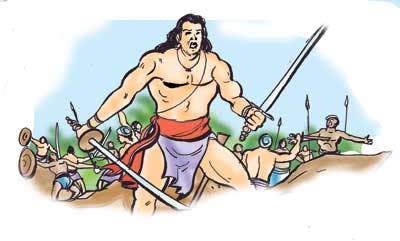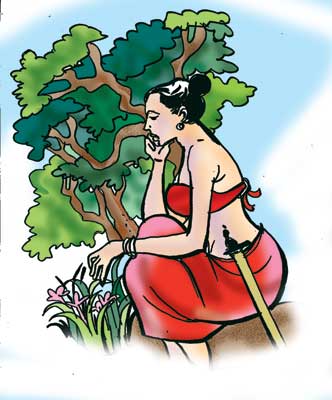
The battle at Tissamaharama
1. The army that advanced through the coastline joined the Tamil Adhikari's forces at Rambha Vihara. They camped there and rested for a few days. The rebels by this time were in the lower valley of the Walawe Ganga. They spread to the east of the area and began to establish their power there. When the Tamil commander went there and attacked them, they had to flee. 2. The armies stationed at Rambha Vihara, left the area to attack the enemy at Hambetamuva and Tissamaharama. The battle at Tissamaharama was a severe one. The enemy forces there were strong and they were under a commander named Sukarabhatudeva. Though he displayed his skill in the battle-field, it did not bear fruit, as this warrior had to die while fighting. With the death of the commander Sukarabhatudeva, the enemy forces were weakened. 3. Though they retreated temporarily, they did not give up. They started fighting once more. The Tamil Adhikari commander's battalion was quick to take action. They were able to chase the enemy as far as Koravakgala near Situlpauva. The enemy army which could not achieve their ambition, came back to Tissamaharama, for the third time. Their one ambition was to win the battle.
4. They adopted various tactics. Though they were not successful in battles that were fought face to face, they won in a number of guerilla skirmishes. They succeeded in weakening the king's army. So they too were not prepared to retreat. They went on fighting. The enemy was adopting guerrilla tactics. Whenever King Parakramabahu's armies went to attack them, they had deserted the place. Even if they happened to stay on, they acted like normal civilians. 5. Now it became difficult to identify the enemy. So the Tamil Adhikari had to adopt another strategy. First he removed his forces from that area. No security measures were adopted. They retreated as far as Damdava, in the hills of Ratnapura. This tactic was to allow the enemy to behave quite freely. 6. This tactic worked. After a few days, seeing no opposition, the rebels came out. They started spreading their power. The Tamil Adhikari commander marched his troops, all of a sudden. He attacked the enemy at several places, including Bogahawela, Urubokka, Beralapanatara and Meegoda. Thus he succeeded in defeating the enemy in the Morawak Korale. Thereafter, he marched his armies to the low-lying areas.
7. The enemy was chased away from Giruva and Magam Pattu areas. His armies then advanced up to Buttala. After conquering that area, they set up camp there. Here, the commander had a discussion with all the Adhikaris. 8. However, the Tamil Adhikari, could not go there as there were serious revolts in Dolosdahasrata. First and foremost, these uprisings had to be suppressed. So they decided to postpone the task of winning over Queen Sugala. Accordingly, the Tamil Adhikari marched his army towards the Walawe Ganga |
|| Front
Page | News | Editorial | Columns | Sports | Plus | Financial
Times | International | Mirror | TV
Times | Funday
Times || |
| |
Reproduction of articles permitted when used without any alterations to contents and the source. |
© Copyright
2007 Wijeya
Newspapers Ltd.Colombo. Sri Lanka. All Rights Reserved. |


